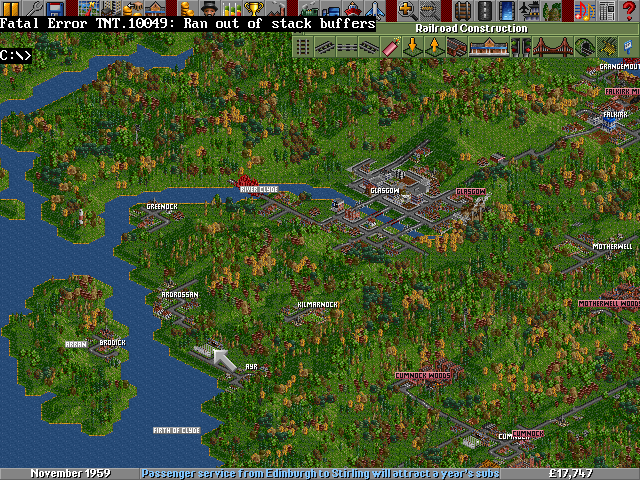First post, by Sal Z
Hi there!
Is it normal that the XMS support is not working in the CVS Builds?
I've tried the AEP, gulikoza and ykhwong CVS builds and all of them have the very same problem: trying to run ANY programs (except some readme scripts) with XMS enabled just give no response: any application just goes back to DosBox Command Line, without any error message.
Even a clean build done with the sources taken from http://pcnwstage.phys.rug.nl/ (just bare emu, no png, no SDL_net, nor SDL_sound) and MSYS give the same wrong behaviour.
DosBox 0.63 gives no problem, even with xms enabled.
At the same time , some applications entirely stopped working: stunts (patched with neverlock) gives back an error message while it ran perfectly with Dosbox 0.63 (look at the screenshot)
Any Idea?
By the way, I'm using a Duron 1400mhz with 512 MB of RAM, Radeon 9250 with the latest drivers and an Asus Nforce A7N266-VM (latest driver and bios, too) on winXP SP2
Here is the Config:
-------------------------------------------------------------------------------------
[sdl]
# fullscreen -- Start dosbox directly in fullscreen.
# fulldouble -- Use double buffering in fullscreen.
# fullfixed -- Don't resize the screen when in fullscreen.
# fullresolution -- What resolution to use for fullscreen, use together with fullfixed.
# output -- What to use for output: surface,overlay,opengl,openglnb,ddraw.
# hwscale -- Extra scaling of window if the output device supports hardware scaling.
# autolock -- Mouse will automatically lock, if you click on the screen.
# sensitiviy -- Mouse sensitivity.
# waitonerror -- Wait before closing the console if dosbox has an error.
# priority -- Priority levels for dosbox: lower,normal,higher,highest.
# Second entry behind the comma is for when dosbox is not focused/minimized.
# mapperfile -- File used to load/save the key/event mappings from.
fullscreen=false
fulldouble=false
fullfixed=false
fullresolution=1024x768
output=surface
hwscale=1.00
autolock=true
sensitivity=100
waitonerror=true
priority=higher,normal
mapperfile=mapper.txt
[dosbox]
# language -- Select another language file.
# memsize -- Amount of memory dosbox has in megabytes.
# machine -- The type of machine tries to emulate:hercules,cga,tandy,vga.
# captures -- Directory where things like wave,midi,screenshot get captured.
language=
machine=vga
captures=capture
memsize=16
[render]
# frameskip -- How many frames dosbox skips before drawing one.
# aspect -- Do aspect correction.
# scaler -- Scaler used to enlarge/enhance low resolution modes.
# Supported are none,normal2x,advmame2x,advmame3x,advinterp2x,interp2x,tv2x.
frameskip=0
aspect=false
scaler=normal2x
[cpu]
# core -- CPU Core used in emulation: simple,normal,full,dynamic.
# cycles -- Amount of instructions dosbox tries to emulate each millisecond.
# Setting this higher than your machine can handle is bad!
# cycleup -- Amount of cycles to increase/decrease with keycombo.
# cycledown Setting it lower than 100 will be a percentage.
core=normal
cycles=3000
cycleup=500
cycledown=20
[mixer]
# nosound -- Enable silent mode, sound is still emulated though.
# rate -- Mixer sample rate, setting any devices higher than this will
# probably lower their sound quality.
# blocksize -- Mixer block size, larger blocks might help sound stuttering
# but sound will also be more lagged.
# prebuffer -- How many milliseconds of data to keep on top of the blocksize.
nosound=false
rate=22050
blocksize=2048
prebuffer=10
[midi]
# mpu401 -- Enable MPU-401 Emulation.
# intelligent -- Operate in Intelligent mode.
# device -- Device that will receive the MIDI data from MPU-401.
# This can be default,alsa,oss,win32,coreaudio,none.
# config -- Special configuration options for the device.
mpu401=true
intelligent=true
device=default
config=
[sblaster]
# type -- Type of sblaster to emulate:none,sb1,sb2,sbpro1,sbpro2,sb16.
# base,irq,dma,hdma -- The IO/IRQ/DMA/High DMA address of the soundblaster.
# mixer -- Allow the soundblaster mixer to modify the dosbox mixer.
# oplmode -- Type of OPL emulation: auto,cms,opl2,dualopl2,opl3.
# On auto the mode is determined by sblaster type.
# oplrate -- Sample rate of OPL music emulation.
type=sb16
base=220
irq=7
dma=1
hdma=5
mixer=true
oplmode=auto
oplrate=22050
[gus]
# gus -- Enable the Gravis Ultrasound emulation.
# base,irq1,irq2,dma1,dma2 -- The IO/IRQ/DMA addresses of the
# Gravis Ultrasound. (Same IRQ's and DMA's are OK.)
# rate -- Sample rate of Ultrasound emulation.
# ultradir -- Path to Ultrasound directory. In this directory
# there should be a MIDI directory that contains
# the patch files for GUS playback. Patch sets used
# with Timidity should work fine.
gus=true
rate=22050
base=240
irq1=5
irq2=5
dma1=3
dma2=3
ultradir=C:\ULTRASND
[speaker]
# pcspeaker -- Enable PC-Speaker emulation.
# pcrate -- Sample rate of the PC-Speaker sound generation.
# tandyrate -- Sample rate of the Tandy 3-Voice generation.
# Tandysound emulation is present if machine is set to tandy.
# disney -- Enable Disney Sound Source emulation.
pcspeaker=true
pcrate=22050
tandyrate=22050
disney=true
[bios]
# Nothing to setup yet!
[dos]
# xms -- Enable XMS support.
# ems -- Enable EMS support.
xms=true
ems=true
[modem]
# modem -- Enable virtual modem emulation.
# comport -- COM Port modem is connected to.
# listenport -- TCP Port the modem listens on for incoming connections.
modem=false
comport=2
listenport=23
[directserial]
# directserial -- Enable serial passthrough support.
# comport -- COM Port inside DOSBox.
# realport -- COM Port on the Host.
# defaultbps -- Default BPS.
# parity -- Parity of the packets. This can be N, E or O.
# bytesize -- Size of each packet. This can be 5 or 8.
# stopbit -- The number of stopbits. This can be 1 or 2.
directserial=false
comport=1
realport=COM1
defaultbps=1200
parity=N
bytesize=8
stopbit=1
[ipx]
# ipx -- Enable ipx over UDP/IP emulation.
ipx=false
[autoexec]
# Lines in this section will be run at startup.
mount C "J:\Documents and Settings\Salvo\Documenti\DOSC"
#mount D D:\ -t cdrom -usecd 0 -ioctl
SET PATH=C:\COMMAND;C:\DOS32A
keyb it
C:
-------------------------------------------------------------------------------------
